| Columns Retired Columns & Blogs |
Love these lil buggers.
I used DRA Labs' MLSSA system and a calibrated DPA 4006 microphone to measure the Paradigm Reference Studio 20 v5's farfield frequency responses, and an Earthworks QTC-40 for the nearfield responses. With a specified anechoic voltage sensitivity of 87dB, the Paradigm actually raised 88.5dB(B) at 1m with 2.83V drive. This is usefully high sensitivity, though the impedance drops below 4 ohms in the lower midrange, reaching a minimum value of 3.45 ohms at 175Hz. However, the impedance remains above 6 ohms for much of the audioband, and as usual, the instances where the electrical phase is high never coincide with low impedance magnitudes. The Studio 20 v5 should be relatively easy for an amplifier to drive.
Other than a slight discontinuity at 25.5kHz, this being the frequency of the metal-dome tweeter's fundamental "oil-can" resonance, the traces in fig.1 are free from the small wrinkles that would imply the presence of cabinet vibrational resonances. Indeed, investigating the behavior of the enclosure's panel, I could find just a couple of very low-level modes (fig.2), though these were present on all surfaces. This is a well-designed, inert cabinet.
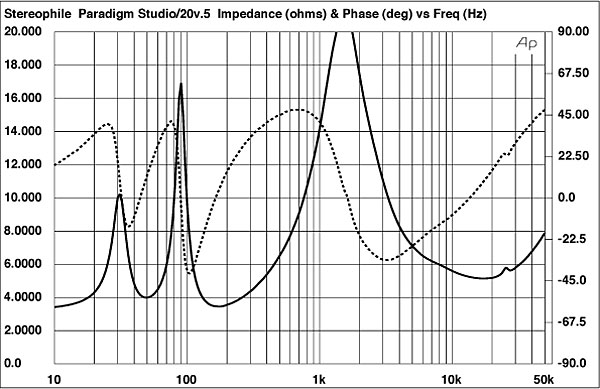

The saddle in the impedance-magnitude trace centered on 47Hz suggest that this is the tuning frequency of the large-diameter port on the front baffle below the woofer. The minimum-motion notch in the woofer's nearfield response (fig.3, blue trace below 350Hz) occurs at 45Hz, and the port's nearfield response (red trace) peaks in the same region, though its output extends a little higher in frequency than usual before rolling off. The nearfield measurement technique exaggerates the level of a speaker's output in the upper bass, but even so, the Studio 20 v5's woofer peaks up a little more than expected, suggesting an underdamped alignment. As BJR wrote, "the only coloration I heard was a slight thickness in the Paradigm's upper bass." Higher in frequency, the woofer's output is disturbed by some peaks and dips before crossing over to the tweeter (green trace), with another couple of peaks evident between 4 and 6kHz, these suppressed by the crossover. The tweeter's output rises gently in its passband, with very narrow peaks and dips evident, these stemming from reflections from the grille.
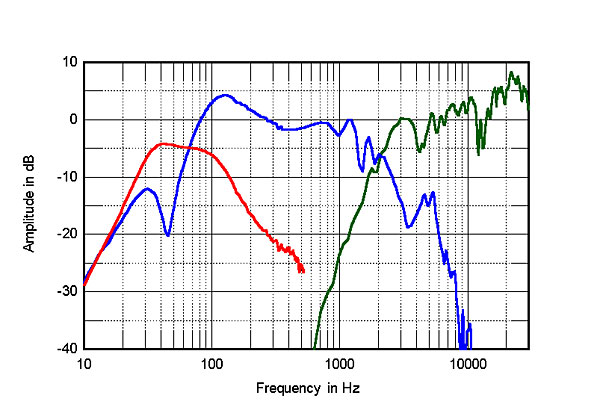
Fig.4 shows how these individual responses sum in the farfield. The low-frequency output peaks before rolling off to eventually reach –6dB at the port tuning frequency. While the response trend in the midrange and treble is basically flat, there is a sharply defined dip between 1 and 2kHz, which appears from fig.3 to stem from the woofer. This is too low in frequency to be due to cone breakup; I suspect it to be the result of a termination problem between the cone and the surround. Fortunately, the dip is very narrow, so it might not have audible consequences. The tweeter's output is again a little irregular; removing the grille gave a smoother response (fig.5, blue trace), but with 2–3dB more output overall above 3kHz, and a higher peak at the tweeter's ultrasonic resonance frequency.
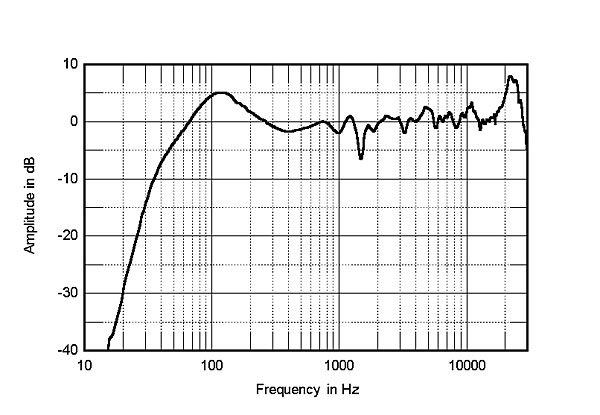
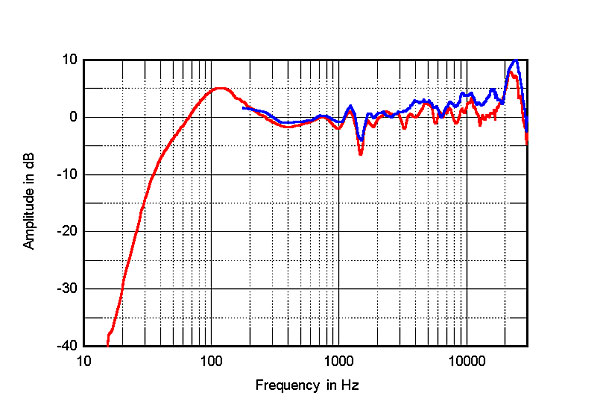
I measured the Studio 20 v5 with its grille in place because the latter continues the smooth profile of the speaker's front baffle in the vicinity of the tweeter. The plot of the Paradigm's lateral dispersion (fig.6) indicates that the small dips in the tweeter-axis response tend to fill in to the speaker's sides, with the off-axis output maintained to above 10kHz. Though there appears to be a slight off-axis flare centered at 1776Hz in this graph, again this is due to the on-axis suckout filling in a little to the speaker's sides. In the vertical plane (fig.7), the Studio 20's even tweeter-axis balance is maintained over a ±10° window.
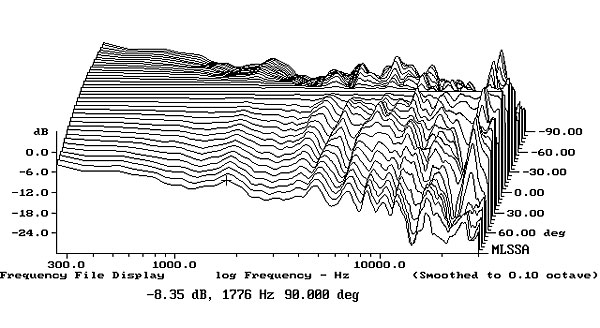
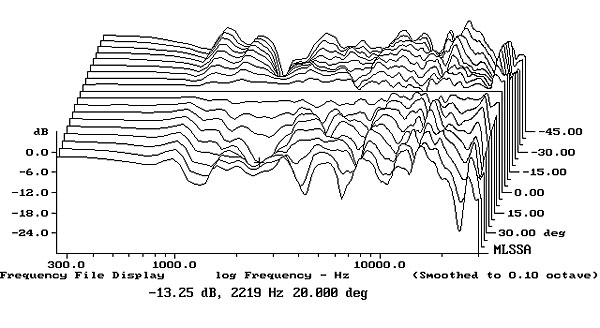
The Paradigm Studio 20 v5's step response on the tweeter axis (fig.8) suggests that both drive-units are connected in positive acoustic polarity, with the decay of the tweeter's step smoothly blending into the rise of the woofer's step. The raggedness of the latter's decay is likely due to reflections from the grille, and some low-frequency vibration can be seen as the woofer's step crosses the time axis. The Studio 20's cumulative spectral-decay plot (fig.9) shows that this delayed energy is related to the upper-midrange dip in the on-axis response; there is also some low-level delayed energy evident in the tweeter's passband.

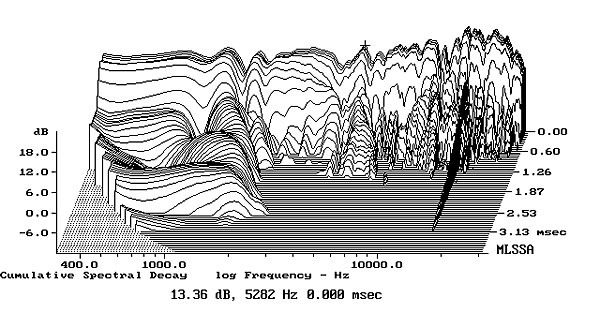
Paradigm's Reference Studio 20 v5 gets a fairly clean bill of health on the test bench. What faults it does have appear to be well managed to minimize their audibility.—John Atkinson


For over two years I've been enjoying this speaker. Very happy to see them get some priase in a publication like this one. HUGE difference over the v.4 as stated in the review (which wasn't a bad desing in it's own right). Great all-around speaker especially if matched with good electronics.

Got a pair a few months ago for my third system . I had it narrowed down to three pair but thanks to Bobs great review I went with the Paradigm's . Thanks Bob .
After listening to them for a few months then rereading the review I can confirm that Bobs sonic description was accurate .
I tried them with quite a few amps before settling on a 200 watt Luxman that I retired a bunch of years ago . At first I felt that the 20's were not capable of playing loud and clean but once I had them properly driven that was not a concern . Also tried a bunch of speaker cables before being content with Cardas's new Clear cable . Great match .
Tim

Until you own one, you can't imagine how heavy they are. They also deserve a very good amplifier, although I drive mine with a Marantz. I must admit that some of Canton's new stand mounts give an airier sound, the Studio 20 gives a presence that few other speakers of this size can.